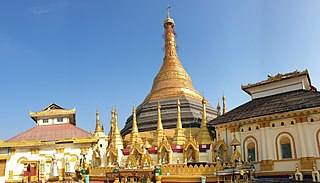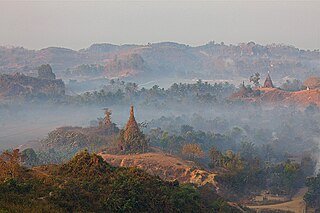
Mawlamyine, formerly Moulmein, is the fourth-largest city in Myanmar (Burma), 300 kilometres (190 mi) south east of Yangon and 70 kilometres (43 mi) south of Thaton, at the mouth of Thanlwin (Salween) River. The city is the capital and largest city of Mon State and the main trading centre and seaport in south eastern Myanmar.

Bago, formerly known as Hanthawaddy, is a city and the capital of the Bago Region in Myanmar. It is located 91 kilometres (57 mi) north-east of Yangon.

Taungoo is a district-level city in the Bago Region of Myanmar, 220 km from Yangon, towards the north-eastern end of the division, with mountain ranges to the east and west. The main industry is in forestry products, with teak and other hardwoods extracted from the mountains. The city is known for its areca palms, to the extent that a Burmese proverb for unexpected good fortune is equated to a "betel lover winning a trip to Taungoo".

Buddhism, specifically Theravāda Buddhism, is the State religion of Myanmar since 1961, and practiced by nearly 90% of the population. It is the most religious Buddhist country in terms of the proportion of monks in the population and proportion of income spent on religion. Adherents are most likely found among the dominant Bamar people, Shan, Rakhine, Mon, Karen, and Chinese who are well integrated into Burmese society. Monks, collectively known as the sangha (community), are venerated members of Burmese society. Among many ethnic groups in Myanmar, including the Bamar and Shan, Theravada Buddhism is practiced in conjunction with the worship of nats, which are spirits who can intercede in worldly affairs.

Mrauk U is a town in northern Rakhine State, Myanmar. It is the capital of Mrauk-U Township, a subregion of the Mrauk-U District.
Battle of Yunnan-Burma Road was the name of the Chinese intervention to aid their British allies in the 1942 Burma Campaign. Its forces were composed of the Fifth, Sixth and Sixty-sixth Army under the command of the Chinese Expeditionary Force in Burma, commanded by Lt. General Joseph Stilwell, Lt. General Luo Zhuoying was his Executive Officer.

The Toungoo dynasty, and also known as the Restored Toungoo dynasty, was the ruling dynasty of Burma (Myanmar) from the mid-16th century to 1752. Its early kings Tabinshwehti and Bayinnaung succeeded in reunifying the territories of the Pagan Kingdom for the first time since 1287 and in incorporating the Shan States for the first time., in addition to including Manipur, Chinese Shan States, Siam and Lan Xang. But the largest empire in the history of Southeast Asia collapsed in the 18 years following Bayinnaung's death in 1581.

The National Museum of Myanmar (Yangon),, located in Dagon, Yangon, is the major one of the two national museums for Burmese art, history and culture in Myanmar. Founded in 1952, the five-storey museum has an extensive collection of ancient artifacts, ornaments, work of art, inscriptions and historic memorabilia, related to history, culture and civilization of Burmese people. The main attraction of the museum is the only surviving original Lion Throne of the Burmese monarchs. There are more than 4000 permanent objects in the museum.

Taungoo District is a district of the Bago Division in central Burma (Myanmar). The capital lies at Taungoo.

The Shwezigon Pagoda Bell Inscription is a multi-language inscription found on the Shwezigon Pagoda Bell, donated by King Bayinnaung of Toungoo Dynasty and located at the Shwezigon Pagoda in Bagan, Burma (Myanmar). Written in Burmese, Mon, and Pali, the inscription lists the important events in the first six years of his reign. It is the only contemporary record in Burmese that calls the king "Conqueror of the Ten Directions", the title by which he is widely known in Mon and Thai.
Mingyi Swe was viceroy of Toungoo (Taungoo) from 1540 to 1549 during the reign of his son-in-law King Tabinshwehti of Toungoo dynasty. He was also the father of King Bayinnaung, as well as key viceroys in Bayinnaung's administration. He rose to the position of viceroy of the ancestral home of the dynasty, after having started out as a royal household servant of Tabinshwehti. All the Toungoo kings from Bayinnaung to Mahadhammaraza Dipadi descended from him.
Dhamma Dewi was one of three principal queens of King Tabinshwehti of Toungoo Dynasty and the elder sister of King Bayinnaung. She was born Khin Hpone Soe, a commoner daughter of royal servants of Prince Tabinshwehti. In November 1530, the prince ascended to the throne as king, and raised her as one of his two principal queens. The queen, who was at least a year older than the king, is said to have been the king's favorite until 1545 when the king raised Khay Ma Naw as his co-chief queen.

Minkhaung I of Toungoo was viceroy of Toungoo from 1446 to 1451. Having accidentally inherited the Toungoo throne after his father's sudden death, Minkhaung proved an ineffectual ruler of this perpetually unruly frontier vassal state of Ava Kingdom. He was assassinated in early 1452 by a servant of his cousin Minye Kyawhtin, who went on to seize Toungoo in his rebellion against King Narapati I of Ava. All royal chronicles starting with the Maha Yazawin chronicle, identify Minkhaung I of Toungoo as an ancestor of King Bayinnaung of Toungoo Dynasty.
Saw Min Hla was the chief queen consort of Ava from 1421 to 1425. Her son Min Hla briefly became king for three months in 1425, following the death of her second husband King Thihathu of Ava. Her first husband was Thihathu's elder brother Crown Prince Minye Kyawswa of the Forty Years' War fame. Her eldest child Minye Kyawhtin was the rebel king of Toungoo (Taungoo) from 1452 to 1459.
Ananda Thuriya was the first governor of Kanba Myint, the region that would later become the Principality of Toungoo (Taungoo), the predecessor state of the Toungoo dynasty. The governor started out his career in the military service of King Sithu II of Pagan (Bagan), rising to commander-in-chief of the royal army. He later became a chief minister at the royal court, and married a daughter of the king. In 1191, he was appointed governor of Kanba Myint,, then a frontier region. He was the paternal great grandfather of Thawun Gyi and Thawun Nge, who founded Toungoo in 1279.
Thawun Gyi was the founder and first ruler of Toungoo (Taungoo), the predecessor state of the Toungoo dynasty of Myanmar. The two-times-great-grandson of King Sithu II founded Toungoo near the end of the Pagan Empire in 1279. He became one of several independent rulers of petty states after the empire's breakup in 1287. He later submitted to Myinsaing, the new power in Upper Burma. Thawun Gyi was assassinated by the men of his younger brother Thawun Nge in 1317.
Thawun Nge was governor of Toungoo (Taungoo) from 1317 to 1324. He came to office by assassinating his elder brother Thawun Gyi while Toungoo's overlord Pinya was facing a serious rebellion at Sagaing. His own rebellion was brief as he struck a deal with Pinya to keep the office in exchange for his submission. He died in 1324, and was succeeded by his son Saw Hnit.

Mahazedi Pagoda is a prominent Buddhist pagoda in Bago, Myanmar.

Laos–Myanmar relations is the long, complicated relationship between two neighbors, Laos and Myanmar. Myanmar has an embassy in Vientiane and Laos has an embassy in Yangon.













